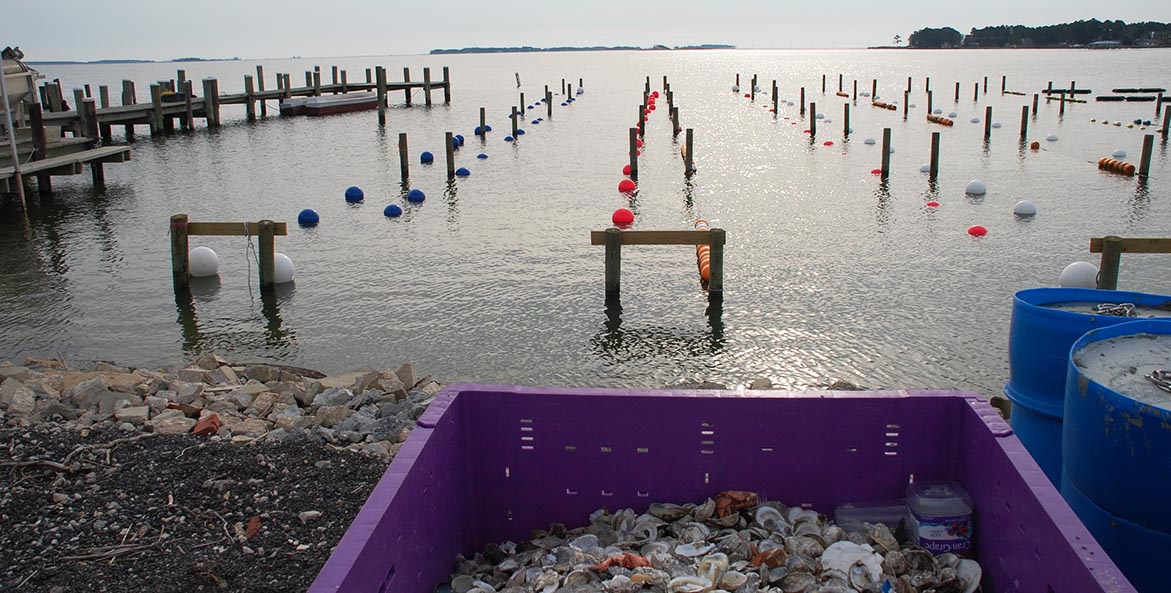What Is Shellfish Aquaculture?
Shellfish aquaculture is the process of cultivating oysters, clams, mussels, or other shellfish for food. By cultivating the Chesapeake Bay's native oyster, Crassostrea virginica, oyster farmers help recover some of the oyster's critical functions in the Bay ecosystem and economy.
Today, aquaculture supports a more than $30 million industry in Maryland and Virginia.
Why Do We Need Aquaculture?
U.S. per capita seafood consumption ranks fourth in the world, yet we barely break the top 25 producers of aquaculture seafood globally. To satisfy our demand, we import nearly $19 billion in seafood, resulting in a $12 billion seafood trade deficit annually. Developing a profitable aquaculture industry would reduce the seafood trade deficit, create jobs in working waterfront communities, and provide consumers with fresh, locally-sourced products.
A report issued by Virginia Tech and Engle-Stone Aquatic$ shows how the industry provides valuable economic benefits and employment opportunities to Maryland's coastal communities. It also supports a diverse suite of economic sectors from real estate and wholesale trade to food service.
Shellfish aquaculture also provides strong ecological benefits. Under natural conditions, oysters form large reef structures that support more than 300 other species, making it a keystone species in the Chesapeake Bay. Unfortunately, oyster populations and their reefs have been reduced to a small fraction of their historical abundance. Fortunately, recent studies have shown that oyster aquaculture gear provides novel habitat to many of the same species that live on oyster reefs. Our native Eastern oyster, Crassostrea virginica, is a prolific filter feeder and a healthy adult can filter 30-50 gallons of water daily, consuming the phytoplankton that grows on excess nutrients in the Bay. These nutrients are removed from the water and retained in the oysters' shells and tissue, improving water quality. When the oysters are harvested, the nutrients are removed with them. In the future, quantifying these ecosystem benefits could allow shellfish growers to receive compensation under a nutrient trading system.
How You Can Support Shellfish Aquaculture
Our partners in the Chesapeake Oyster Alliance and the Maryland Shellfish Growers Network figured out new ways to bring the tasty bivalve to your plate. Find out where to buy Chesapeake Bay-farmed oysters and help a local company that is helping to save the Bay.
The New Farm-to-Table Economy
The growth of oyster farming has provided valuable employment opportunities for watermen and others while filtering water and providing habitat for animals like fish and crabs. Follow the journey of aquaculture from the oyster farm to your table.
-

Hatchery operators collect native oysters from the wild, or use native oysters that have been bred to resist disease.
-

Broodstock spawn and produce oyster larvae. They can either be placed in setting tanks where they attach to empty oyster shells, or grown in tanks until they are big enough to be placed in cages.
-

Farmed oysters grow for approximately two years while they help filter water and provide habitat. Oysters attached to shells grow on a shell base on the bottom. Oysters in cages are placed near the Bay bottom or float on the surface.
-

Bottom-grown oysters are harvested using tongs or dredges. Single oysters are removed from their cages.
-

Processors sort and check oysters for quality. Some are bagged and boxed for distribution, and others are shucked and sold in jars or cans.
-

Some packers sell directly to restaurants and the public. Others sell through wholesalers.
-

Ask for local, farm-raised Chesapeake Bay oysters at your favorite restaurants and markets.
-

Eat an oyster, save the Bay! Enjoy on the half shell, or in your favorite recipe.



